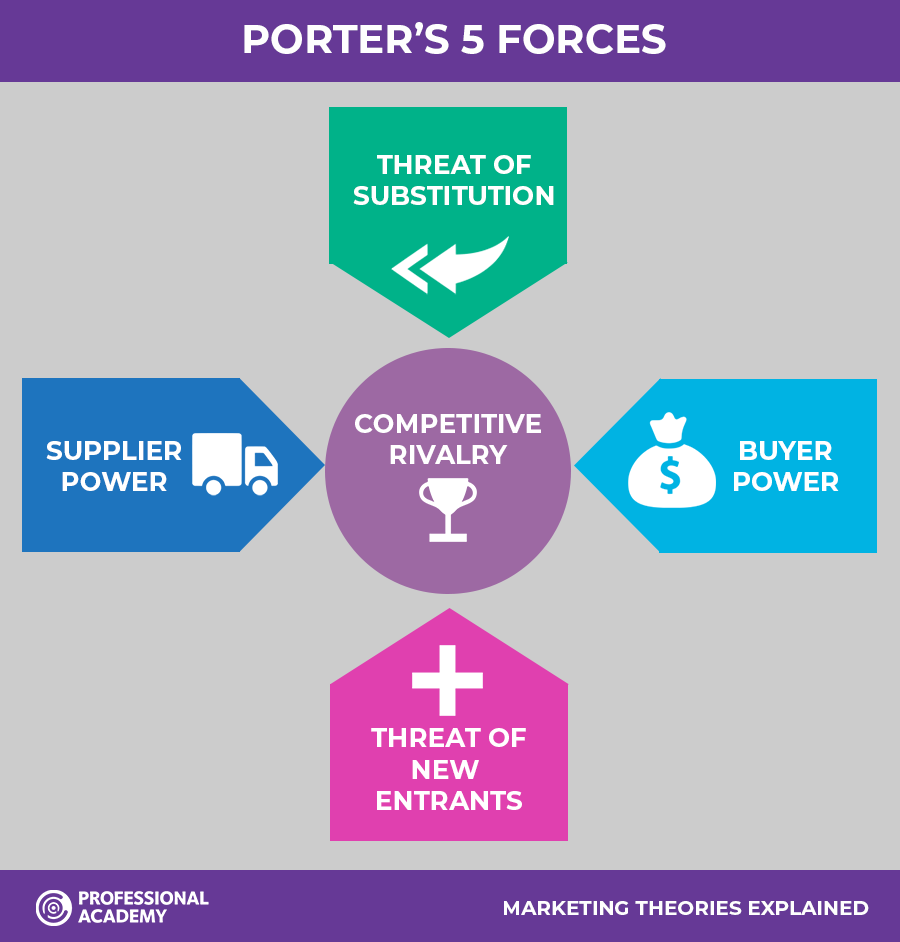

Visit our Marketing Theories Page to see more of our marketing buzzword busting blogs.
Porter's five forces is another tool belonging to the marketer’s strategy toolkit. This one is used to assess the level of competitive intensity within your industry. As the name suggests, the concept was created by a fellow by the name of Michael E. Porter.
Porter believed that by understanding the level of competitive intensity, you could determine the attractiveness of that industry. When we talk about industry attractiveness we are talking about the profitability of the industry not how much we like it!
So how do we as marketers assess the level of competitive intensity in our industry? Well Porter believes there are five factors, or five forces acting upon your organisation that will determine this (hence the name!)

Clearly a key factor in competitive intensity will be competitive rivalry. So what do marketers need to consider?
If an industry is perceived as attractive then of course new entrants are highly likely to appear. If too many new entrants appear then profitability across the industry will be lowered and the attractiveness will decline. The threat of new entrants can be lowered or even blocked by the largest companies that have somewhat of a monopoly over the industry. Marketers will need to consider:
Customers may choose to substitute your product or service for another. This is not the same as switching to a different company to use the same product but switching products entirely. For example switching from a regular phone to a smartphone, or from a sugary snack to a healthy alternative snack. The more products that continue to appear, the higher the chances your customers will be drawn to an alternative from their usual choice. How can marketers confront this?
We all have suppliers, whether it is raw materials, knowledge support or physical staff labour. Marketers know that a great deal of research and consultation will be done in order to attain the best suppliers at the best price. But what if there is very little choice of suppliers? The fewer suppliers there are, the more power they have over you and the prices they charge. Marketers should consider:
When the buyers themselves have power they can apply pressure to companies, in particular pressure to lower their prices. If the buyer has many choices of products and companies then their power is high. If buyers decide to join together so that a large portion of the market share is putting pressure on companies then they again have high power. How can marketers prepare for this?
So you can see how this tool may prove useful for marketers and strategy consultants. It allows them to see their current strategic position and plan for the future by acting on their strengths and addressing their weaknesses. It can be especially useful when considering entering a new industry in highlighting how likely you are to succeed. Of course other tools would also be beneficial for assessing issues outside of competitive intensity when planning any kind of strategic action plan.
If you're more of a visual learner, check out this short animated video that outlines how to use Poter's Five Forces in marketing.
Porters Five Forces are taught as part of both the CIM Level 4 Certificate and Level 6 Diploma in Professional Marketing as well as throughout the ISM Sales Qualifications. To learn more about these qualifications why not get in touch today or speak to a qualification advisor using the chat function below.
If you would like help referencing this blog, check out our Harvard Referencing Blog.